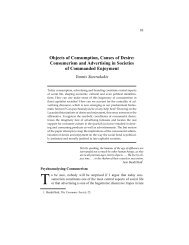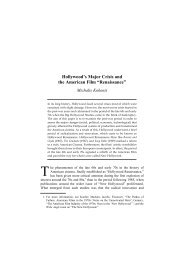19 International Symposium on Theoretical and Applied Linguistics ...
19 International Symposium on Theoretical and Applied Linguistics ...
19 International Symposium on Theoretical and Applied Linguistics ...
Create successful ePaper yourself
Turn your PDF publications into a flip-book with our unique Google optimized e-Paper software.
G E N E R A L S E S S I O N<br />
L1 transfer in L2 learning: compound forms in the speech of Turkish learners of Greek<br />
Marina Tzakosta<br />
University of Crete/ Greek State Scholarships foundati<strong>on</strong><br />
martzak@gmail.com<br />
Greek compounding has been extensively dealt with theoretically (cf. Ράλλη <str<strong>on</strong>g>19</str<strong>on</strong>g>99, Nespor & Ralli<br />
<str<strong>on</strong>g>19</str<strong>on</strong>g>96, Ralli 2005); however, little has been said regarding compound formati<strong>on</strong> in sec<strong>on</strong>d language<br />
learning (L2). In this study, we evaluate the capacity of Greek native speakers <strong>and</strong> Turkish learners of<br />
Greek to form compound words placing emphasis <strong>on</strong> a) their internal structure, b) their headedness, c)<br />
the relati<strong>on</strong> holding between the compound elements <strong>and</strong> d) the status of the linking vowel. In an offline<br />
task, 40 native speakers of Greek (age range: 18-58 years), had to form a) existing compounds<br />
(test 1) <strong>and</strong> b) morphologically possible but semantically vague compounds (test 2). The same test<br />
was distributed to Turkish learners of Greek (age range: 10-12 years).<br />
Native speakers exhibit a high degree of variati<strong>on</strong> in the formati<strong>on</strong> of endocentric compounds (1a).<br />
Therefore, the syllable receiving stress <strong>and</strong> the inflecti<strong>on</strong>al suffix vary. In case the sec<strong>on</strong>d compound<br />
c<strong>on</strong>stituent retains its inflecti<strong>on</strong>al suffix, a syllable of the sec<strong>on</strong>d compound member receives stress. If<br />
the sec<strong>on</strong>d compound member does not retain its inflecti<strong>on</strong>al suffix, the linking vowel is stressed.<br />
Variati<strong>on</strong> is also attested in compounds of different classes, i.e. [[stem+stem]+deriv.Suff.] <strong>and</strong><br />
[stem+word] forms (cf.Nespor&Ralli <str<strong>on</strong>g>19</str<strong>on</strong>g>96, Ralli 2005), which are used interchangeably (1b).<br />
Apparently, the two compound classes are not recognized as distinct. Additi<strong>on</strong>ally, the head of the<br />
word is often ambiguously perceived. In (1c) the actual head appears either at the left or right edge of<br />
the word, depending <strong>on</strong> whether the head has been perceived as the head of the word or not (cf.<br />
Jarema et al. <str<strong>on</strong>g>19</str<strong>on</strong>g>99, Kehayia et al. <str<strong>on</strong>g>19</str<strong>on</strong>g>99, Tsapkini et al. <str<strong>on</strong>g>19</str<strong>on</strong>g>99). Head mispercepti<strong>on</strong> leads to semantic<br />
ambiguity. Finally, the linking vowel appears in envir<strong>on</strong>ments where it could be ph<strong>on</strong>ologically<br />
prohibited (sec<strong>on</strong>d example in (1d)). Variable forms appear more systematically in test 2 compared to<br />
test 1. Obviously, variati<strong>on</strong> in test 1 is restricted by mnem<strong>on</strong>ic mechanisms which drive compound<br />
formati<strong>on</strong>.<br />
L2 data display equivalent patterns of variati<strong>on</strong>. However, compounding in L2 is clearly influenced<br />
by L1 word formati<strong>on</strong> mechanisms. Therefore, compound heads are ambiguously perceived not <strong>on</strong>ly<br />
in exocentric but also in endocentric compounds (2). A related outcome of Greek L2 is that Turkish<br />
learners prefer two-word compounds to <strong>on</strong>e-word compounds. Additi<strong>on</strong>ally, given that linking vowels<br />
do not appear in Turkish compounds, Turkish learners exhibit variable forms with <strong>and</strong> without linking<br />
vowels (examples in 2a, 2c). Moreover, stress may shift bey<strong>on</strong>d the trisyllabic window, given that<br />
trisyllabicity is not respected in Turkish (first example in 2c). Statistically, [[stem+stem]+deriv.Suff]<br />
forms are more prevalent in L2. This prevalence is theoretically founded in that Turkish compounds<br />
lack inflecti<strong>on</strong>al suffixes.<br />
In sum, the degree of variati<strong>on</strong> in compound formati<strong>on</strong> is determined by the extent to which<br />
mnem<strong>on</strong>ic mechanisms are activated. Mnem<strong>on</strong>ic knowledge, which prohibits variati<strong>on</strong> in the formati<strong>on</strong><br />
of existing words, is minimized in the formati<strong>on</strong> of n<strong>on</strong>-existing words. Variati<strong>on</strong> in L2 compound<br />
learning is additi<strong>on</strong>ally driven by mechanisms active in the learners’ L1.<br />
(1) a. ασχηµ-ο-πούλ+ι vs. ασχηµ-ό-πουλ+ο ‘ugly bird–NEUT.NOM.SG.’(Test 1)<br />
b. βαρι-ό-σκαλ+α vs. βαρι-ο-σκάλ+α ‘heavy staircase–FEM.NOM .SG.’(Test 2)<br />
c. κρεατ-ό-ρυζο vs. ρυζ-ό-κρεας ‘meat rice–NEUT.NOM.SG.’ (Test 1)<br />
head head<br />
d. νερ-Ø-έµπορος vs. νερ-ο-έµπορος ‘water seller–MASC.NOM.SG.’(Test 2)<br />
(2) a. βαρι-Ø-σκάλα vs. βαρι-ο-σκάλα vs. σκαλ-ό-βαρο ‘heavy staircase–FEM.NOM.SG.’ (Test 2)<br />
b. κρε-ό-ρυζ+ο vs. κρε-ο-ρύζ+ο/-ι ‘meat rice–NEUT.NOM.SG.’ (Test 1)<br />
c. νερ-ό-εµπoρος vs. νερ-Ø-έµπορος vs. εµπορ-ό-νερος ‘water seller–MASC.NOM.SG.’(Test 2)<br />
Exploring the influence of the interview<br />
as a research method <strong>on</strong> the c<strong>on</strong>structi<strong>on</strong> of identities in narrative<br />
Dorien Van De Mieroop<br />
Lessius / KULeuven<br />
dorien.v<strong>and</strong>emieroop@lessius.eu<br />
Narratives are an important means by which individuals make sense of their lives <strong>and</strong> by which they<br />
perceive <strong>and</strong> c<strong>on</strong>struct identities. On the basis of social c<strong>on</strong>structivist insights, this self is regarded as<br />
<str<strong>on</strong>g>19</str<strong>on</strong>g> th ISTAL 59






